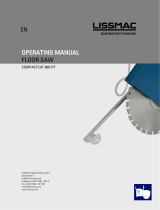
3 Safety
20
Wet-cutting
Use a water sprayer when dust formation is excessive, e.g. when cutting
concrete or stone.
Only use cutting blades that are suitable for wet cutting.
Before ending the wet cutting process, allow the cutting blade to run without the
water sprayer until it is dry.
Not exceeding the maximum tilt position
Do not exceed the maximum tilt position (see the description in the Maximum
permissible tilt chapter).
Only operate the machine at maximum tilt for short periods of time.
If you exceed the maximum tilt, the engine lubrication system will fail and thus
inevitably damage important engine parts.
Notes regarding work methods
Fold down the protective hood fully. The protective hood can catch material
flung away from the work area and divert it away from the operator.
Particularly when starting the engine you have to make sure that the cutting
blade does not come into contact with anything.
Always operate the machine at full throttle even when first placing it into the
cut.
When first placing the the cutting blade into the cut, set it slowly onto the
material. Excessive pressure can damage the cutting blade.
Move the machine in a straight line together with the cutting blade. Pressure
from the side can damage the cutting blade.
Avoid cutting tight curves.
On sloping carriageways and surfaces, pressure must not be applied to the
side of the blade.
Never exceed the maximum speed (printed on cutting blade).
Removing foreign objects before cutting
Before cutting, remove foreign objects such as nails, etc. from the cutting area.
Cutting various materials
Do not process loose materials (e.g. paving stones).
Do not cut into the gravel area using diamond-edged cutting blades.
When cutting on the edge of the track or when cutting two different materials
(cutting in the joint area), uneven wear is possible.






















